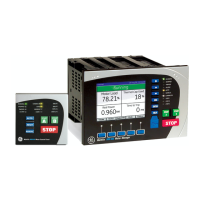CHAPTER 2: INSTALLATION MAINTENANCE
MM300 MOTOR MANAGEMENT SYSTEM – QUICKSTART GUIDE 17
The MM300 monitors up to six RTD inputs for stator, bearing, ambient, or other
temperature monitoring types. The type of each RTD is 100 ohm platinum (DIN 43760).
RTDs must be three-wire type.
The RTD circuitry compensates for lead resistance, provided that each of the three leads is
the same length. Lead resistance should not exceed 25 ohms per lead. Shielded cable
should be used to prevent noise pickup in industrial environments. RTD cables should be
kept close to grounded metal casings and away from areas of high electromagnetic or
radio interference. RTD leads should not be run adjacent to or in the same conduit as high
current carrying wires.
Figure 2-21: RTD wiring
Maintenance
The MM300 requires minimal maintenance. As a microprocessor-based relay, its
characteristics do not change over time. The expected service life of an MM300 is 20 years
when the environment and electrical conditions are within stated specifications.
While the MM300 performs continual self-tests, it is recommended that maintenance be
scheduled with other system maintenance. This maintenance can involve in-service, out-
of-service, or unscheduled maintenance.
In-service maintenance
1. Visual verification of the analog values integrity, such as voltage and current (in
comparison to other devices on the corresponding system).
Motor
starter
Motor
Three-wire shielded cable
RTD
terminals in
motor starter
RTD terminals
at motor
Maximum total lead resistance:
25 ohms for Platinum RTDs
Route cable in separate conduit from
current carrying conductors
RTD in motor
stator or
bearing
853737A3.CDR
MM300 Motor Protection Syst em
Surge ground
~13
~4
~3
~2
~1
Compensation
Return
Hot
Shield
RTD1
~8
~7
~6
~5
Compensation
Return
Hot
Shield
RTD2
~12
~11
~10
~9
Compensation
Return
Hot
Shield
RTD3
N/C
~14

